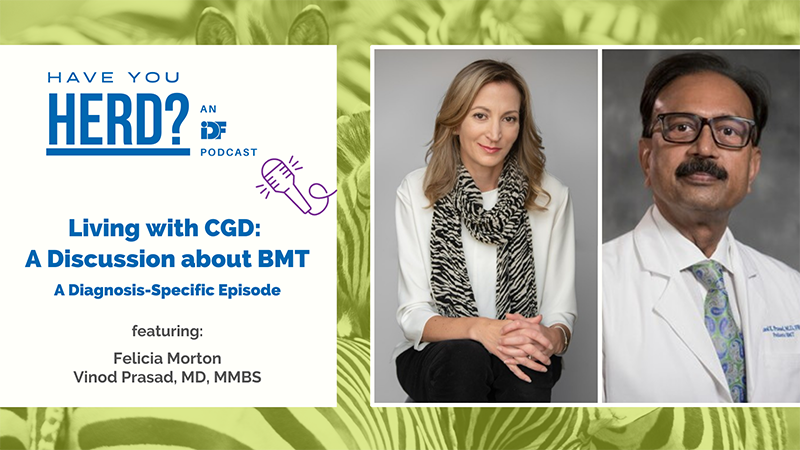
-
Understanding primary immunodeficiency (PI)

Understanding PI
The more you understand about primary immunodeficiency (PI), the better you can live with the disease or support others in your life with PI. Learn more about PI, including the various diagnoses and treatment options.
-
Living with PI
-
Addressing mental health
-
Explaining your diagnosis
- General care
- Get support
- For parents and guardians
-
Managing workplace issues
- Navigating insurance
-
Traveling safely

Living with PI
Living with primary immunodeficiency (PI) can be challenging, but you’re not alone—many people with PI lead full and active lives. With the right support and resources, you can, too.
-
Addressing mental health
-
Get involved

Get involved
Be a hero for those with PI. Change lives by promoting primary immunodeficiency (PI) awareness and taking action in your community through advocacy, donating, volunteering, or fundraising.
-
Advancing research and clinical care
-
Grants
-
IDF surveys
-
Participating in clinical trials
-
Diagnosing PI
-
Consulting immunologist
-
Clinician education

Advancing research and clinical care
Whether you’re a clinician, researcher, or an individual with primary immunodeficiency (PI), IDF has resources to help you advance the field. Get details on surveys, grants, and clinical trials.
-
Grants
Hematopoietic stem cell transplant (HSCT), also known as bone marrow transplant (BMT), is a treatment option for children with chronic granulomatous disease (CGD), but caregivers and healthcare providers must weigh several factors before moving ahead with the procedure.
To provide an overview of considerations for treating CGD with BMT, IDF produced a podcast, “Living with CGD: A Discussion about BMT.” The podcast is hosted by Felicia Morton, executive director of the CGD Association of America and mother of a son who received BMT for CGD, and features Dr. Vinod Prasad, director of the pediatric transplant and cellular therapy division at Duke University Hospital. Prasad has worked with CGD patients for 30 years.
Parents may consider BMT for their child as a longer-term treatment versus choosing infection management through preventative antibiotics and antifungals, other medications, and gamma interferon. A BMT replaces blood-forming cells with the CGD mutation with ones from a donor that can produce functional white blood cells, resulting in an immune system that is able to fight infection.
“We know how difficult it is to make that decision because you can live with CGD or you can go through treatment and both have very difficult and challenging risks associated with them,” said Morton.
Prasad described CGD, a rare primary immunodeficiency, as a collection of chronic health problems. In addition to being vulnerable to multiple infections from bacteria and fungi, persons with CGD develop granulomas, or nodules, in the body that could be external in the lymph nodes or internal on organs like the lungs, colon, kidneys, or any other part of the body where they can cause compression to vital organs. CGD also can cause immune-mediated problems, and impact growth and development.
“You can continue to do supportive care for a period of time, but the disease doesn’t go away. It always comes back. It always leads to infections and other complications over the years, and significant impact on the quality of life, on the growth and development of the child,” said Prasad.
“Being in and out of the hospital takes a toll on the children, as well as on the families, and the only curative action that we have right now is to do HSCT.”
Three primary factors influencing the decision to move forward with BMT include:
- How severe is the disease?
- Is there an appropriate donor available?
- Is there access to a good transplant center?
“It’s a very personal decision and your transplant doctor should be able to make it with you,” said Prasad.
While there is no ideal time to transplant, children from late infancy to early teens respond the best to BMT, though the younger the child, the better because younger children are more resilient. Prasad stressed that it’s important to move forward with BMT before multiple severe infections develop and damage major organs such as lungs and kidneys. Start looking for transplant options and donor options early, he said.
“Once you have an idea that your child is suffering from severe disease, then waiting is not going to make the transplant outcomes better. Prolonged delay will only make the transplant outcomes worse and that’s why it should be done early,” said Prasad.
The various donor options, which are dictated by human leukocyte antigens (HLA) matching, include:
- Haploidentical (sibling or parent) donor.
- Unrelated bone marrow donor.
- Unrelated umbilical cord donor.
“Truly today I feel so fortunate being in the field of transplantation that we can almost always find a donor for a patient who needs a transplant compared to when I first saw my first CGD patient 30 years ago,” said Prasad.
Gene therapy, which is in clinical trials, is another option for treating CGD. In gene therapy, doctors fix the defective gene in the person with CGD.
“I would suggest that we certainly consider gene therapy as an option if there is a clinical trial that is open at the time that your child needs treatment or you need treatment and reach out to those clinical trial groups and see if you qualify for the gene therapy,” said Prasad.
How can families prepare themselves for BMT? “The transplant is not an easy procedure to go through either for the patient or the family,” said Dr. Prasad.
Families should consider the following points:
- Be prepared to commit six months to a year to the treatment.
- The hospital stay could last two to three months.
- You may have to relocate and live close to the transplant center.
- Treatment has both short-term and long-term risks.
- Try to keep the family unit intact as best you can.
- Seek help from the child life specialists.
“The most important thing is if you are considering a transplant, consider it early, meet with a transplant team either virtually or in person, ask all the questions that you have, and then make a decision about where to do the transplant and how to do the transplant,” said Dr. Prasad.
Sign up for updates from IDF
Receive news and helpful resources to your cell phone or inbox. You can change or cancel your subscription at any time.





The Immune Deficiency Foundation improves the diagnosis, treatment, and quality of life for every person affected by primary immunodeficiency.
We foster a community that is connected, engaged, and empowered through advocacy, education, and research.
Combined Charity Campaign | CFC# 66309





